Intellectual Property Rights in Modern World: An Essay Analysis
VerifiedAdded on 2022/08/28
|8
|1933
|21
Essay
AI Summary
This essay delves into the multifaceted realm of Intellectual Property Rights (IPR), exploring its core concepts, advantages, and disadvantages within the context of both developed and developing nations. The report begins by defining IPR and its various forms, including patents, copyrights, trademarks, and trade secrets. It then critically analyzes the arguments for and against the existence of IPR, emphasizing its role in incentivizing innovation and providing legal protection. The essay further examines the advantages of IPR, such as providing exclusive rights to creators, encouraging information sharing, and fostering economic benefits. Simultaneously, it acknowledges the shortcomings, including increased costs, potential quality reduction, and the risk of piracy. The essay concludes by underscoring the crucial role of IPR in the modern world, with a particular emphasis on the need for developing countries to align with international standards while also establishing their own IPR frameworks to promote innovation and protect intellectual assets. The report uses several references to support its arguments and provide a comprehensive understanding of the topic.
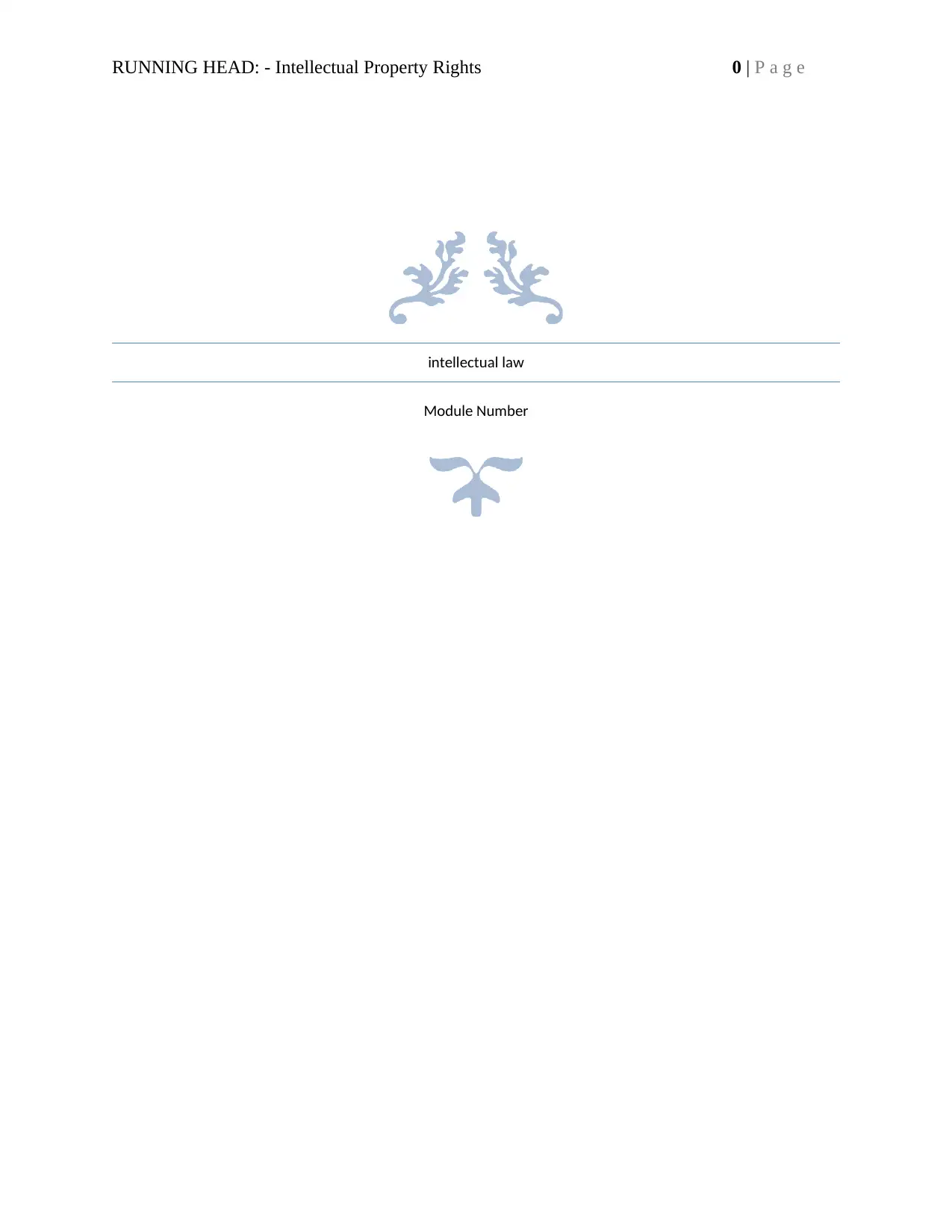
RUNNING HEAD: - Intellectual Property Rights 0 | P a g e
intellectual law
Module Number
intellectual law
Module Number
Paraphrase This Document
Need a fresh take? Get an instant paraphrase of this document with our AI Paraphraser
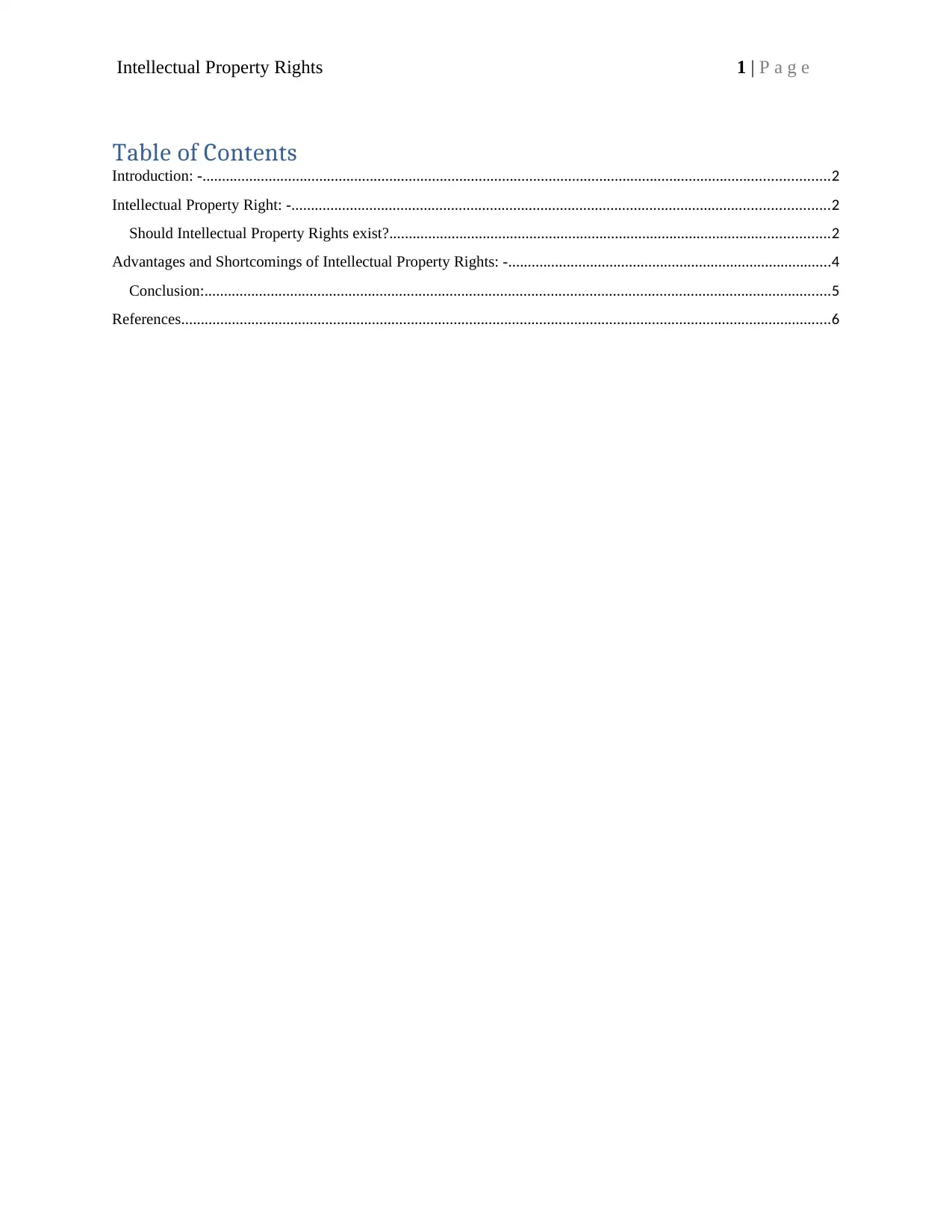
Intellectual Property Rights 1 | P a g e
Table of Contents
Introduction: -.................................................................................................................................................................2
Intellectual Property Right: -..........................................................................................................................................2
Should Intellectual Property Rights exist?.................................................................................................................2
Advantages and Shortcomings of Intellectual Property Rights: -...................................................................................4
Conclusion:.................................................................................................................................................................5
References.......................................................................................................................................................................6
Table of Contents
Introduction: -.................................................................................................................................................................2
Intellectual Property Right: -..........................................................................................................................................2
Should Intellectual Property Rights exist?.................................................................................................................2
Advantages and Shortcomings of Intellectual Property Rights: -...................................................................................4
Conclusion:.................................................................................................................................................................5
References.......................................................................................................................................................................6
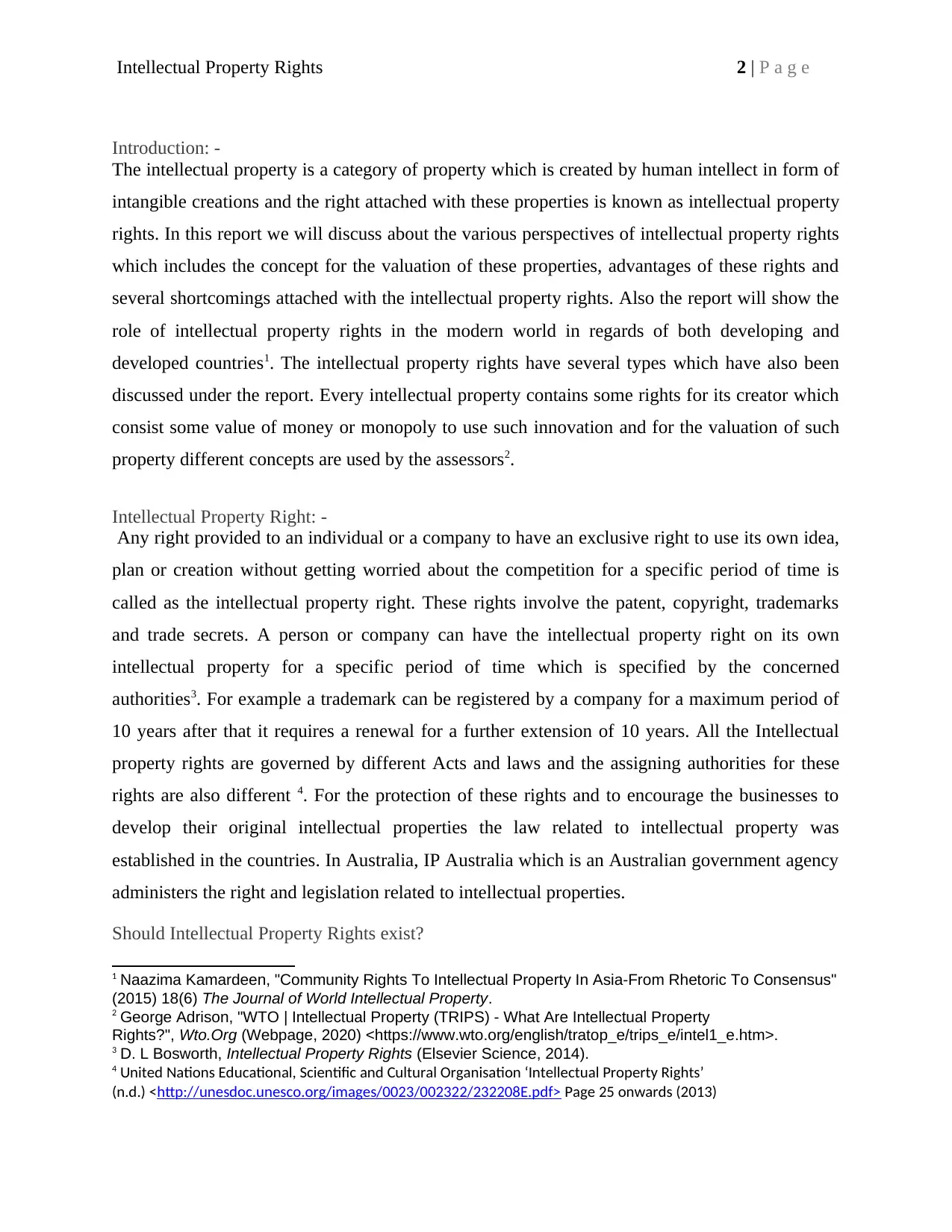
Intellectual Property Rights 2 | P a g e
Introduction: -
The intellectual property is a category of property which is created by human intellect in form of
intangible creations and the right attached with these properties is known as intellectual property
rights. In this report we will discuss about the various perspectives of intellectual property rights
which includes the concept for the valuation of these properties, advantages of these rights and
several shortcomings attached with the intellectual property rights. Also the report will show the
role of intellectual property rights in the modern world in regards of both developing and
developed countries1. The intellectual property rights have several types which have also been
discussed under the report. Every intellectual property contains some rights for its creator which
consist some value of money or monopoly to use such innovation and for the valuation of such
property different concepts are used by the assessors2.
Intellectual Property Right: -
Any right provided to an individual or a company to have an exclusive right to use its own idea,
plan or creation without getting worried about the competition for a specific period of time is
called as the intellectual property right. These rights involve the patent, copyright, trademarks
and trade secrets. A person or company can have the intellectual property right on its own
intellectual property for a specific period of time which is specified by the concerned
authorities3. For example a trademark can be registered by a company for a maximum period of
10 years after that it requires a renewal for a further extension of 10 years. All the Intellectual
property rights are governed by different Acts and laws and the assigning authorities for these
rights are also different 4. For the protection of these rights and to encourage the businesses to
develop their original intellectual properties the law related to intellectual property was
established in the countries. In Australia, IP Australia which is an Australian government agency
administers the right and legislation related to intellectual properties.
Should Intellectual Property Rights exist?
1 Naazima Kamardeen, "Community Rights To Intellectual Property In Asia-From Rhetoric To Consensus"
(2015) 18(6) The Journal of World Intellectual Property.
2 George Adrison, "WTO | Intellectual Property (TRIPS) - What Are Intellectual Property
Rights?", Wto.Org (Webpage, 2020) <https://www.wto.org/english/tratop_e/trips_e/intel1_e.htm>.
3 D. L Bosworth, Intellectual Property Rights (Elsevier Science, 2014).
4 United Nations Educational, Scientific and Cultural Organisation ‘Intellectual Property Rights’
(n.d.) <http://unesdoc.unesco.org/images/0023/002322/232208E.pdf> Page 25 onwards (2013)
Introduction: -
The intellectual property is a category of property which is created by human intellect in form of
intangible creations and the right attached with these properties is known as intellectual property
rights. In this report we will discuss about the various perspectives of intellectual property rights
which includes the concept for the valuation of these properties, advantages of these rights and
several shortcomings attached with the intellectual property rights. Also the report will show the
role of intellectual property rights in the modern world in regards of both developing and
developed countries1. The intellectual property rights have several types which have also been
discussed under the report. Every intellectual property contains some rights for its creator which
consist some value of money or monopoly to use such innovation and for the valuation of such
property different concepts are used by the assessors2.
Intellectual Property Right: -
Any right provided to an individual or a company to have an exclusive right to use its own idea,
plan or creation without getting worried about the competition for a specific period of time is
called as the intellectual property right. These rights involve the patent, copyright, trademarks
and trade secrets. A person or company can have the intellectual property right on its own
intellectual property for a specific period of time which is specified by the concerned
authorities3. For example a trademark can be registered by a company for a maximum period of
10 years after that it requires a renewal for a further extension of 10 years. All the Intellectual
property rights are governed by different Acts and laws and the assigning authorities for these
rights are also different 4. For the protection of these rights and to encourage the businesses to
develop their original intellectual properties the law related to intellectual property was
established in the countries. In Australia, IP Australia which is an Australian government agency
administers the right and legislation related to intellectual properties.
Should Intellectual Property Rights exist?
1 Naazima Kamardeen, "Community Rights To Intellectual Property In Asia-From Rhetoric To Consensus"
(2015) 18(6) The Journal of World Intellectual Property.
2 George Adrison, "WTO | Intellectual Property (TRIPS) - What Are Intellectual Property
Rights?", Wto.Org (Webpage, 2020) <https://www.wto.org/english/tratop_e/trips_e/intel1_e.htm>.
3 D. L Bosworth, Intellectual Property Rights (Elsevier Science, 2014).
4 United Nations Educational, Scientific and Cultural Organisation ‘Intellectual Property Rights’
(n.d.) <http://unesdoc.unesco.org/images/0023/002322/232208E.pdf> Page 25 onwards (2013)
⊘ This is a preview!⊘
Do you want full access?
Subscribe today to unlock all pages.

Trusted by 1+ million students worldwide
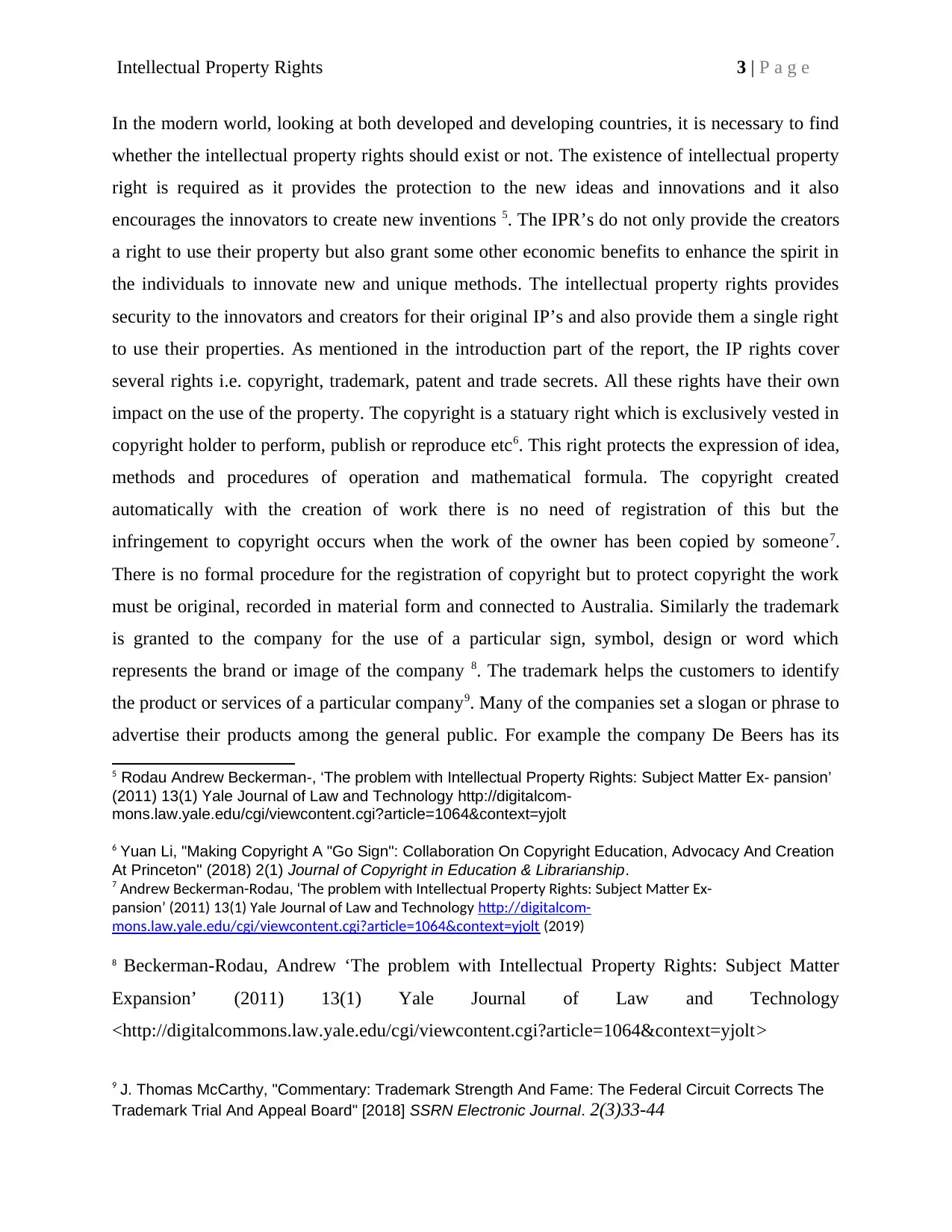
Intellectual Property Rights 3 | P a g e
In the modern world, looking at both developed and developing countries, it is necessary to find
whether the intellectual property rights should exist or not. The existence of intellectual property
right is required as it provides the protection to the new ideas and innovations and it also
encourages the innovators to create new inventions 5. The IPR’s do not only provide the creators
a right to use their property but also grant some other economic benefits to enhance the spirit in
the individuals to innovate new and unique methods. The intellectual property rights provides
security to the innovators and creators for their original IP’s and also provide them a single right
to use their properties. As mentioned in the introduction part of the report, the IP rights cover
several rights i.e. copyright, trademark, patent and trade secrets. All these rights have their own
impact on the use of the property. The copyright is a statuary right which is exclusively vested in
copyright holder to perform, publish or reproduce etc6. This right protects the expression of idea,
methods and procedures of operation and mathematical formula. The copyright created
automatically with the creation of work there is no need of registration of this but the
infringement to copyright occurs when the work of the owner has been copied by someone7.
There is no formal procedure for the registration of copyright but to protect copyright the work
must be original, recorded in material form and connected to Australia. Similarly the trademark
is granted to the company for the use of a particular sign, symbol, design or word which
represents the brand or image of the company 8. The trademark helps the customers to identify
the product or services of a particular company9. Many of the companies set a slogan or phrase to
advertise their products among the general public. For example the company De Beers has its
5 Rodau Andrew Beckerman-, ‘The problem with Intellectual Property Rights: Subject Matter Ex- pansion’
(2011) 13(1) Yale Journal of Law and Technology http://digitalcom-
mons.law.yale.edu/cgi/viewcontent.cgi?article=1064&context=yjolt
6 Yuan Li, "Making Copyright A "Go Sign": Collaboration On Copyright Education, Advocacy And Creation
At Princeton" (2018) 2(1) Journal of Copyright in Education & Librarianship.
7 Andrew Beckerman-Rodau, ‘The problem with Intellectual Property Rights: Subject Matter Ex-
pansion’ (2011) 13(1) Yale Journal of Law and Technology http://digitalcom-
mons.law.yale.edu/cgi/viewcontent.cgi?article=1064&context=yjolt (2019)
8 Beckerman-Rodau, Andrew ‘The problem with Intellectual Property Rights: Subject Matter
Expansion’ (2011) 13(1) Yale Journal of Law and Technology
<http://digitalcommons.law.yale.edu/cgi/viewcontent.cgi?article=1064&context=yjolt>
9 J. Thomas McCarthy, "Commentary: Trademark Strength And Fame: The Federal Circuit Corrects The
Trademark Trial And Appeal Board" [2018] SSRN Electronic Journal. 2(3)33-44
In the modern world, looking at both developed and developing countries, it is necessary to find
whether the intellectual property rights should exist or not. The existence of intellectual property
right is required as it provides the protection to the new ideas and innovations and it also
encourages the innovators to create new inventions 5. The IPR’s do not only provide the creators
a right to use their property but also grant some other economic benefits to enhance the spirit in
the individuals to innovate new and unique methods. The intellectual property rights provides
security to the innovators and creators for their original IP’s and also provide them a single right
to use their properties. As mentioned in the introduction part of the report, the IP rights cover
several rights i.e. copyright, trademark, patent and trade secrets. All these rights have their own
impact on the use of the property. The copyright is a statuary right which is exclusively vested in
copyright holder to perform, publish or reproduce etc6. This right protects the expression of idea,
methods and procedures of operation and mathematical formula. The copyright created
automatically with the creation of work there is no need of registration of this but the
infringement to copyright occurs when the work of the owner has been copied by someone7.
There is no formal procedure for the registration of copyright but to protect copyright the work
must be original, recorded in material form and connected to Australia. Similarly the trademark
is granted to the company for the use of a particular sign, symbol, design or word which
represents the brand or image of the company 8. The trademark helps the customers to identify
the product or services of a particular company9. Many of the companies set a slogan or phrase to
advertise their products among the general public. For example the company De Beers has its
5 Rodau Andrew Beckerman-, ‘The problem with Intellectual Property Rights: Subject Matter Ex- pansion’
(2011) 13(1) Yale Journal of Law and Technology http://digitalcom-
mons.law.yale.edu/cgi/viewcontent.cgi?article=1064&context=yjolt
6 Yuan Li, "Making Copyright A "Go Sign": Collaboration On Copyright Education, Advocacy And Creation
At Princeton" (2018) 2(1) Journal of Copyright in Education & Librarianship.
7 Andrew Beckerman-Rodau, ‘The problem with Intellectual Property Rights: Subject Matter Ex-
pansion’ (2011) 13(1) Yale Journal of Law and Technology http://digitalcom-
mons.law.yale.edu/cgi/viewcontent.cgi?article=1064&context=yjolt (2019)
8 Beckerman-Rodau, Andrew ‘The problem with Intellectual Property Rights: Subject Matter
Expansion’ (2011) 13(1) Yale Journal of Law and Technology
<http://digitalcommons.law.yale.edu/cgi/viewcontent.cgi?article=1064&context=yjolt>
9 J. Thomas McCarthy, "Commentary: Trademark Strength And Fame: The Federal Circuit Corrects The
Trademark Trial And Appeal Board" [2018] SSRN Electronic Journal. 2(3)33-44
Paraphrase This Document
Need a fresh take? Get an instant paraphrase of this document with our AI Paraphraser
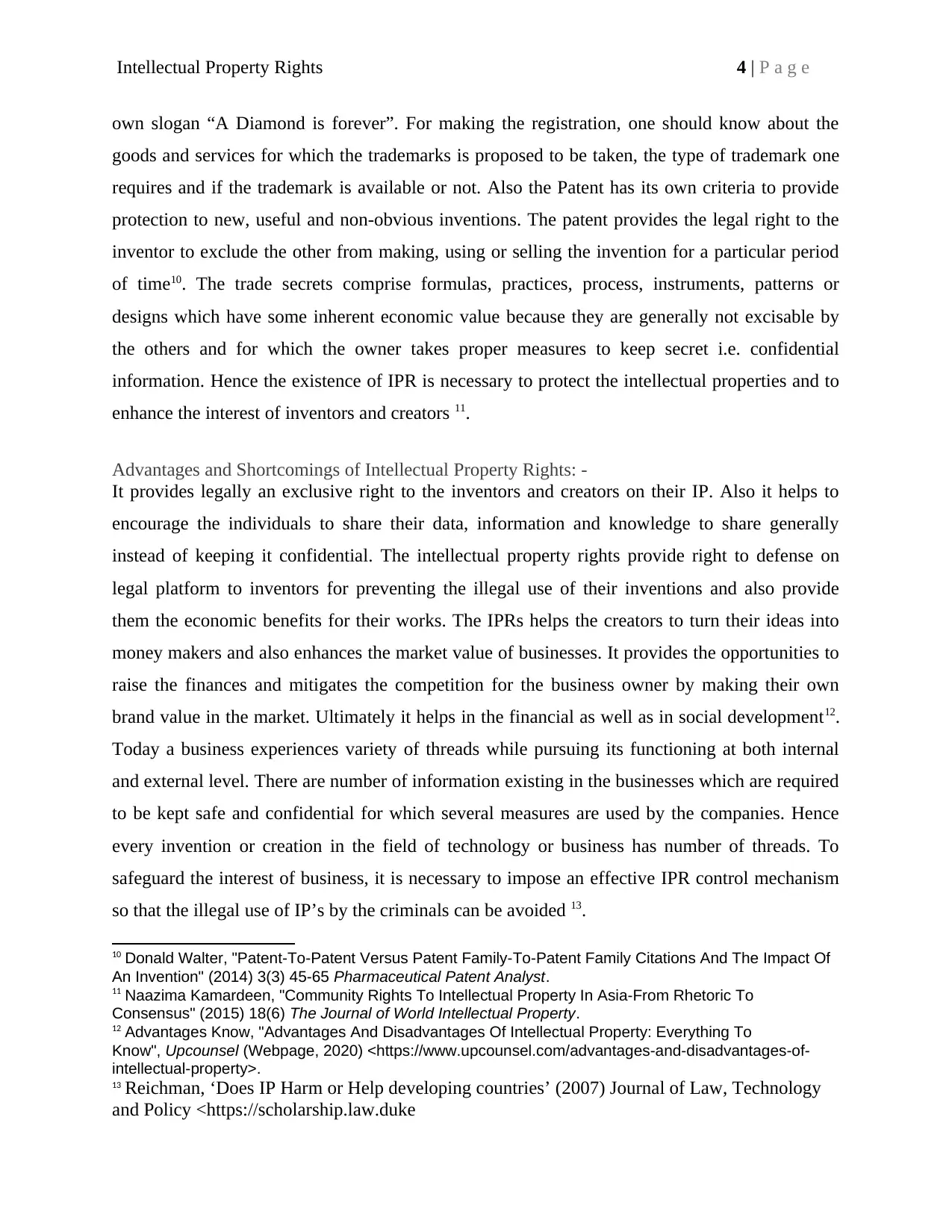
Intellectual Property Rights 4 | P a g e
own slogan “A Diamond is forever”. For making the registration, one should know about the
goods and services for which the trademarks is proposed to be taken, the type of trademark one
requires and if the trademark is available or not. Also the Patent has its own criteria to provide
protection to new, useful and non-obvious inventions. The patent provides the legal right to the
inventor to exclude the other from making, using or selling the invention for a particular period
of time10. The trade secrets comprise formulas, practices, process, instruments, patterns or
designs which have some inherent economic value because they are generally not excisable by
the others and for which the owner takes proper measures to keep secret i.e. confidential
information. Hence the existence of IPR is necessary to protect the intellectual properties and to
enhance the interest of inventors and creators 11.
Advantages and Shortcomings of Intellectual Property Rights: -
It provides legally an exclusive right to the inventors and creators on their IP. Also it helps to
encourage the individuals to share their data, information and knowledge to share generally
instead of keeping it confidential. The intellectual property rights provide right to defense on
legal platform to inventors for preventing the illegal use of their inventions and also provide
them the economic benefits for their works. The IPRs helps the creators to turn their ideas into
money makers and also enhances the market value of businesses. It provides the opportunities to
raise the finances and mitigates the competition for the business owner by making their own
brand value in the market. Ultimately it helps in the financial as well as in social development12.
Today a business experiences variety of threads while pursuing its functioning at both internal
and external level. There are number of information existing in the businesses which are required
to be kept safe and confidential for which several measures are used by the companies. Hence
every invention or creation in the field of technology or business has number of threads. To
safeguard the interest of business, it is necessary to impose an effective IPR control mechanism
so that the illegal use of IP’s by the criminals can be avoided 13.
10 Donald Walter, "Patent-To-Patent Versus Patent Family-To-Patent Family Citations And The Impact Of
An Invention" (2014) 3(3) 45-65 Pharmaceutical Patent Analyst.
11 Naazima Kamardeen, "Community Rights To Intellectual Property In Asia-From Rhetoric To
Consensus" (2015) 18(6) The Journal of World Intellectual Property.
12 Advantages Know, "Advantages And Disadvantages Of Intellectual Property: Everything To
Know", Upcounsel (Webpage, 2020) <https://www.upcounsel.com/advantages-and-disadvantages-of-
intellectual-property>.
13 Reichman, ‘Does IP Harm or Help developing countries’ (2007) Journal of Law, Technology
and Policy <https://scholarship.law.duke
own slogan “A Diamond is forever”. For making the registration, one should know about the
goods and services for which the trademarks is proposed to be taken, the type of trademark one
requires and if the trademark is available or not. Also the Patent has its own criteria to provide
protection to new, useful and non-obvious inventions. The patent provides the legal right to the
inventor to exclude the other from making, using or selling the invention for a particular period
of time10. The trade secrets comprise formulas, practices, process, instruments, patterns or
designs which have some inherent economic value because they are generally not excisable by
the others and for which the owner takes proper measures to keep secret i.e. confidential
information. Hence the existence of IPR is necessary to protect the intellectual properties and to
enhance the interest of inventors and creators 11.
Advantages and Shortcomings of Intellectual Property Rights: -
It provides legally an exclusive right to the inventors and creators on their IP. Also it helps to
encourage the individuals to share their data, information and knowledge to share generally
instead of keeping it confidential. The intellectual property rights provide right to defense on
legal platform to inventors for preventing the illegal use of their inventions and also provide
them the economic benefits for their works. The IPRs helps the creators to turn their ideas into
money makers and also enhances the market value of businesses. It provides the opportunities to
raise the finances and mitigates the competition for the business owner by making their own
brand value in the market. Ultimately it helps in the financial as well as in social development12.
Today a business experiences variety of threads while pursuing its functioning at both internal
and external level. There are number of information existing in the businesses which are required
to be kept safe and confidential for which several measures are used by the companies. Hence
every invention or creation in the field of technology or business has number of threads. To
safeguard the interest of business, it is necessary to impose an effective IPR control mechanism
so that the illegal use of IP’s by the criminals can be avoided 13.
10 Donald Walter, "Patent-To-Patent Versus Patent Family-To-Patent Family Citations And The Impact Of
An Invention" (2014) 3(3) 45-65 Pharmaceutical Patent Analyst.
11 Naazima Kamardeen, "Community Rights To Intellectual Property In Asia-From Rhetoric To
Consensus" (2015) 18(6) The Journal of World Intellectual Property.
12 Advantages Know, "Advantages And Disadvantages Of Intellectual Property: Everything To
Know", Upcounsel (Webpage, 2020) <https://www.upcounsel.com/advantages-and-disadvantages-of-
intellectual-property>.
13 Reichman, ‘Does IP Harm or Help developing countries’ (2007) Journal of Law, Technology
and Policy <https://scholarship.law.duke
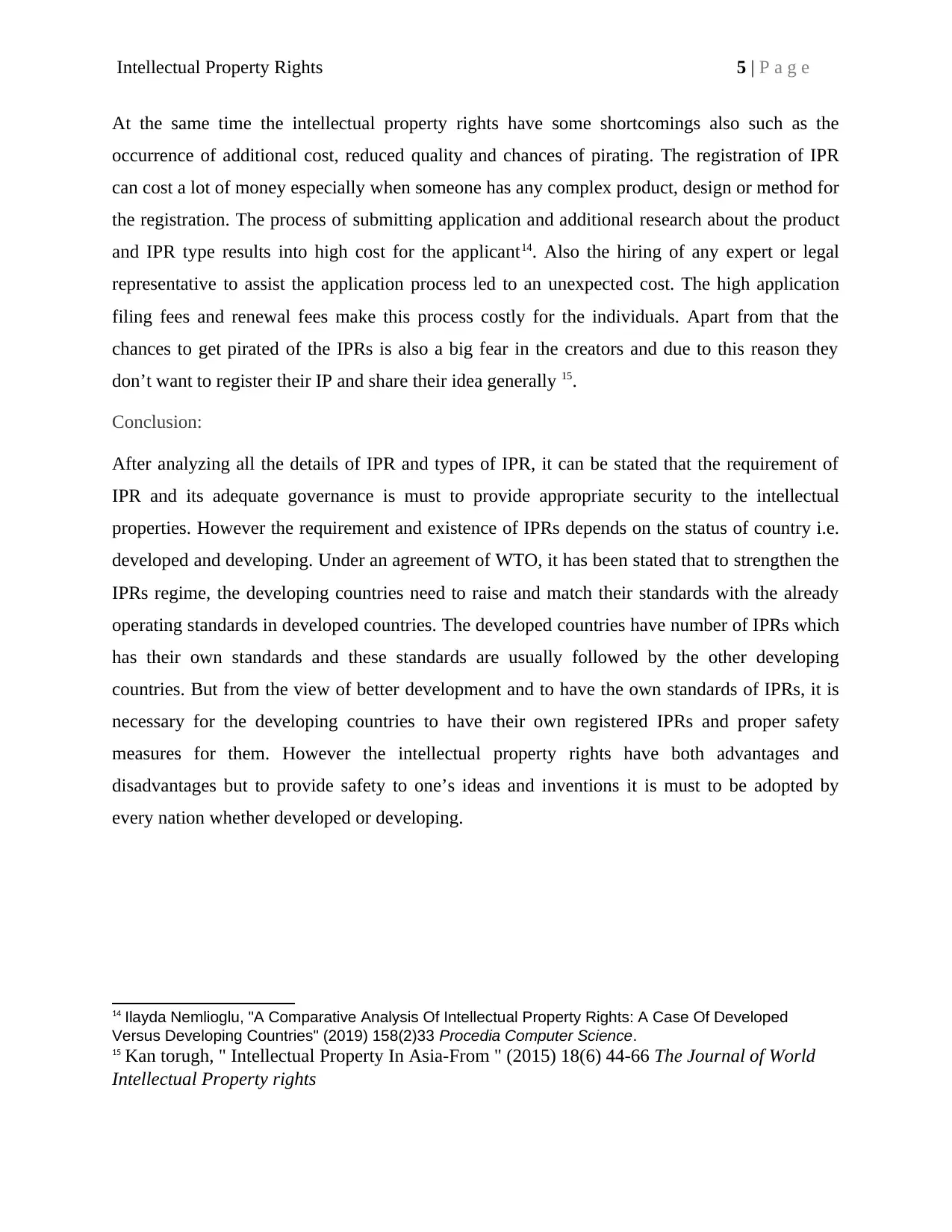
Intellectual Property Rights 5 | P a g e
At the same time the intellectual property rights have some shortcomings also such as the
occurrence of additional cost, reduced quality and chances of pirating. The registration of IPR
can cost a lot of money especially when someone has any complex product, design or method for
the registration. The process of submitting application and additional research about the product
and IPR type results into high cost for the applicant14. Also the hiring of any expert or legal
representative to assist the application process led to an unexpected cost. The high application
filing fees and renewal fees make this process costly for the individuals. Apart from that the
chances to get pirated of the IPRs is also a big fear in the creators and due to this reason they
don’t want to register their IP and share their idea generally 15.
Conclusion:
After analyzing all the details of IPR and types of IPR, it can be stated that the requirement of
IPR and its adequate governance is must to provide appropriate security to the intellectual
properties. However the requirement and existence of IPRs depends on the status of country i.e.
developed and developing. Under an agreement of WTO, it has been stated that to strengthen the
IPRs regime, the developing countries need to raise and match their standards with the already
operating standards in developed countries. The developed countries have number of IPRs which
has their own standards and these standards are usually followed by the other developing
countries. But from the view of better development and to have the own standards of IPRs, it is
necessary for the developing countries to have their own registered IPRs and proper safety
measures for them. However the intellectual property rights have both advantages and
disadvantages but to provide safety to one’s ideas and inventions it is must to be adopted by
every nation whether developed or developing.
14 Ilayda Nemlioglu, "A Comparative Analysis Of Intellectual Property Rights: A Case Of Developed
Versus Developing Countries" (2019) 158(2)33 Procedia Computer Science.
15 Kan torugh, " Intellectual Property In Asia-From " (2015) 18(6) 44-66 The Journal of World
Intellectual Property rights
At the same time the intellectual property rights have some shortcomings also such as the
occurrence of additional cost, reduced quality and chances of pirating. The registration of IPR
can cost a lot of money especially when someone has any complex product, design or method for
the registration. The process of submitting application and additional research about the product
and IPR type results into high cost for the applicant14. Also the hiring of any expert or legal
representative to assist the application process led to an unexpected cost. The high application
filing fees and renewal fees make this process costly for the individuals. Apart from that the
chances to get pirated of the IPRs is also a big fear in the creators and due to this reason they
don’t want to register their IP and share their idea generally 15.
Conclusion:
After analyzing all the details of IPR and types of IPR, it can be stated that the requirement of
IPR and its adequate governance is must to provide appropriate security to the intellectual
properties. However the requirement and existence of IPRs depends on the status of country i.e.
developed and developing. Under an agreement of WTO, it has been stated that to strengthen the
IPRs regime, the developing countries need to raise and match their standards with the already
operating standards in developed countries. The developed countries have number of IPRs which
has their own standards and these standards are usually followed by the other developing
countries. But from the view of better development and to have the own standards of IPRs, it is
necessary for the developing countries to have their own registered IPRs and proper safety
measures for them. However the intellectual property rights have both advantages and
disadvantages but to provide safety to one’s ideas and inventions it is must to be adopted by
every nation whether developed or developing.
14 Ilayda Nemlioglu, "A Comparative Analysis Of Intellectual Property Rights: A Case Of Developed
Versus Developing Countries" (2019) 158(2)33 Procedia Computer Science.
15 Kan torugh, " Intellectual Property In Asia-From " (2015) 18(6) 44-66 The Journal of World
Intellectual Property rights
⊘ This is a preview!⊘
Do you want full access?
Subscribe today to unlock all pages.

Trusted by 1+ million students worldwide
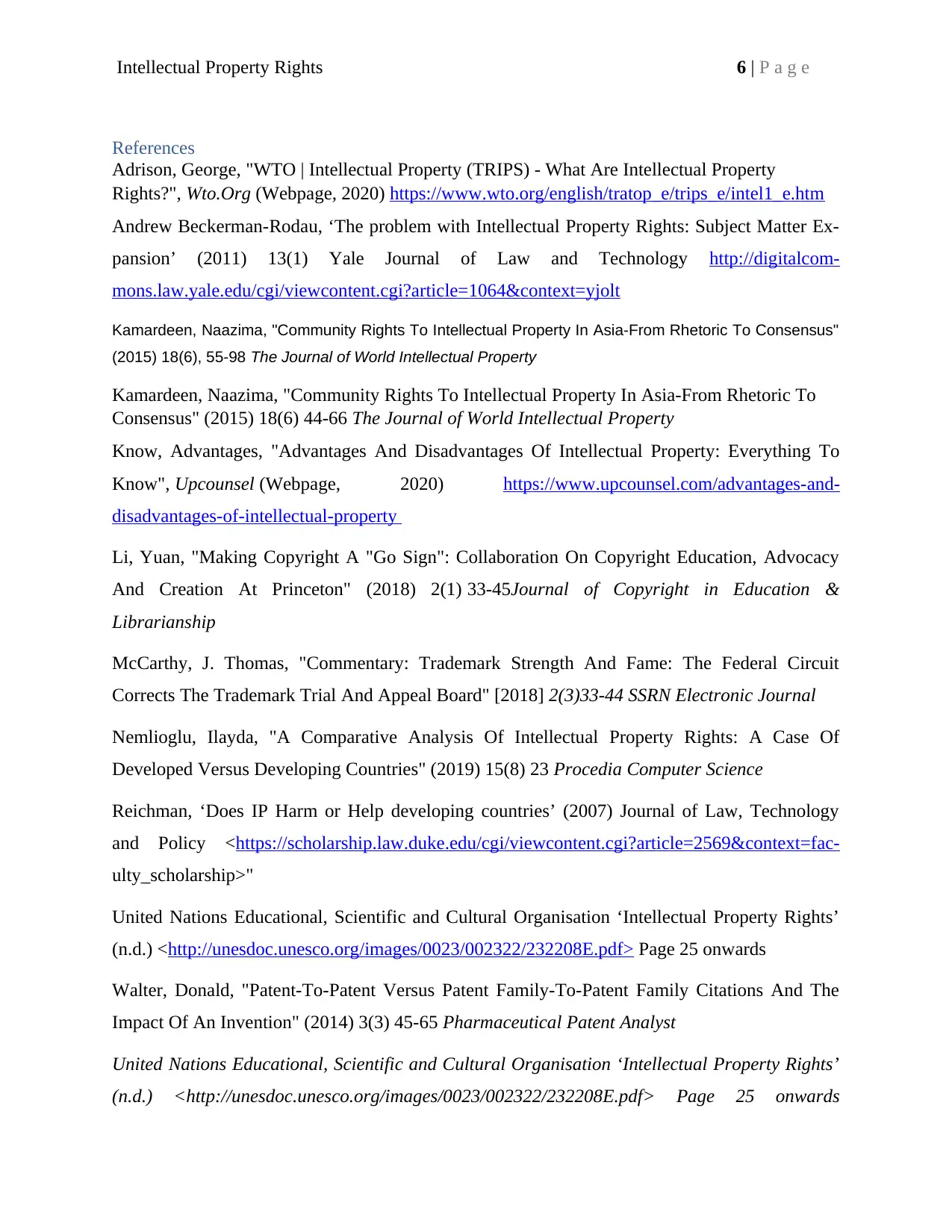
Intellectual Property Rights 6 | P a g e
References
Adrison, George, "WTO | Intellectual Property (TRIPS) - What Are Intellectual Property
Rights?", Wto.Org (Webpage, 2020) https://www.wto.org/english/tratop_e/trips_e/intel1_e.htm
Andrew Beckerman-Rodau, ‘The problem with Intellectual Property Rights: Subject Matter Ex-
pansion’ (2011) 13(1) Yale Journal of Law and Technology http://digitalcom-
mons.law.yale.edu/cgi/viewcontent.cgi?article=1064&context=yjolt
Kamardeen, Naazima, "Community Rights To Intellectual Property In Asia-From Rhetoric To Consensus"
(2015) 18(6), 55-98 The Journal of World Intellectual Property
Kamardeen, Naazima, "Community Rights To Intellectual Property In Asia-From Rhetoric To
Consensus" (2015) 18(6) 44-66 The Journal of World Intellectual Property
Know, Advantages, "Advantages And Disadvantages Of Intellectual Property: Everything To
Know", Upcounsel (Webpage, 2020) https://www.upcounsel.com/advantages-and-
disadvantages-of-intellectual-property
Li, Yuan, "Making Copyright A "Go Sign": Collaboration On Copyright Education, Advocacy
And Creation At Princeton" (2018) 2(1) 33-45Journal of Copyright in Education &
Librarianship
McCarthy, J. Thomas, "Commentary: Trademark Strength And Fame: The Federal Circuit
Corrects The Trademark Trial And Appeal Board" [2018] 2(3)33-44 SSRN Electronic Journal
Nemlioglu, Ilayda, "A Comparative Analysis Of Intellectual Property Rights: A Case Of
Developed Versus Developing Countries" (2019) 15(8) 23 Procedia Computer Science
Reichman, ‘Does IP Harm or Help developing countries’ (2007) Journal of Law, Technology
and Policy <https://scholarship.law.duke.edu/cgi/viewcontent.cgi?article=2569&context=fac-
ulty_scholarship>"
United Nations Educational, Scientific and Cultural Organisation ‘Intellectual Property Rights’
(n.d.) <http://unesdoc.unesco.org/images/0023/002322/232208E.pdf> Page 25 onwards
Walter, Donald, "Patent-To-Patent Versus Patent Family-To-Patent Family Citations And The
Impact Of An Invention" (2014) 3(3) 45-65 Pharmaceutical Patent Analyst
United Nations Educational, Scientific and Cultural Organisation ‘Intellectual Property Rights’
(n.d.) <http://unesdoc.unesco.org/images/0023/002322/232208E.pdf> Page 25 onwards
References
Adrison, George, "WTO | Intellectual Property (TRIPS) - What Are Intellectual Property
Rights?", Wto.Org (Webpage, 2020) https://www.wto.org/english/tratop_e/trips_e/intel1_e.htm
Andrew Beckerman-Rodau, ‘The problem with Intellectual Property Rights: Subject Matter Ex-
pansion’ (2011) 13(1) Yale Journal of Law and Technology http://digitalcom-
mons.law.yale.edu/cgi/viewcontent.cgi?article=1064&context=yjolt
Kamardeen, Naazima, "Community Rights To Intellectual Property In Asia-From Rhetoric To Consensus"
(2015) 18(6), 55-98 The Journal of World Intellectual Property
Kamardeen, Naazima, "Community Rights To Intellectual Property In Asia-From Rhetoric To
Consensus" (2015) 18(6) 44-66 The Journal of World Intellectual Property
Know, Advantages, "Advantages And Disadvantages Of Intellectual Property: Everything To
Know", Upcounsel (Webpage, 2020) https://www.upcounsel.com/advantages-and-
disadvantages-of-intellectual-property
Li, Yuan, "Making Copyright A "Go Sign": Collaboration On Copyright Education, Advocacy
And Creation At Princeton" (2018) 2(1) 33-45Journal of Copyright in Education &
Librarianship
McCarthy, J. Thomas, "Commentary: Trademark Strength And Fame: The Federal Circuit
Corrects The Trademark Trial And Appeal Board" [2018] 2(3)33-44 SSRN Electronic Journal
Nemlioglu, Ilayda, "A Comparative Analysis Of Intellectual Property Rights: A Case Of
Developed Versus Developing Countries" (2019) 15(8) 23 Procedia Computer Science
Reichman, ‘Does IP Harm or Help developing countries’ (2007) Journal of Law, Technology
and Policy <https://scholarship.law.duke.edu/cgi/viewcontent.cgi?article=2569&context=fac-
ulty_scholarship>"
United Nations Educational, Scientific and Cultural Organisation ‘Intellectual Property Rights’
(n.d.) <http://unesdoc.unesco.org/images/0023/002322/232208E.pdf> Page 25 onwards
Walter, Donald, "Patent-To-Patent Versus Patent Family-To-Patent Family Citations And The
Impact Of An Invention" (2014) 3(3) 45-65 Pharmaceutical Patent Analyst
United Nations Educational, Scientific and Cultural Organisation ‘Intellectual Property Rights’
(n.d.) <http://unesdoc.unesco.org/images/0023/002322/232208E.pdf> Page 25 onwards
Paraphrase This Document
Need a fresh take? Get an instant paraphrase of this document with our AI Paraphraser
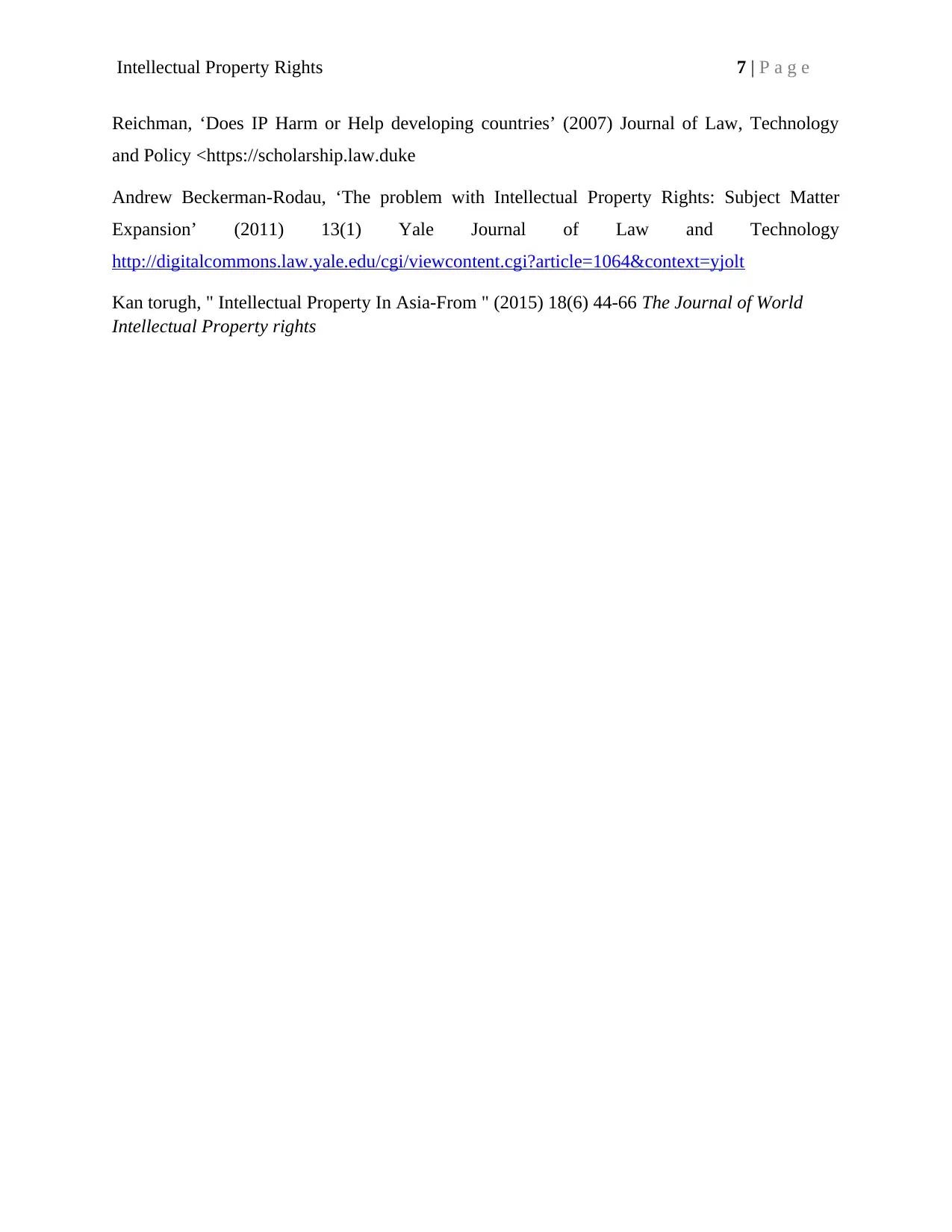
Intellectual Property Rights 7 | P a g e
Reichman, ‘Does IP Harm or Help developing countries’ (2007) Journal of Law, Technology
and Policy <https://scholarship.law.duke
Andrew Beckerman-Rodau, ‘The problem with Intellectual Property Rights: Subject Matter
Expansion’ (2011) 13(1) Yale Journal of Law and Technology
http://digitalcommons.law.yale.edu/cgi/viewcontent.cgi?article=1064&context=yjolt
Kan torugh, " Intellectual Property In Asia-From " (2015) 18(6) 44-66 The Journal of World
Intellectual Property rights
Reichman, ‘Does IP Harm or Help developing countries’ (2007) Journal of Law, Technology
and Policy <https://scholarship.law.duke
Andrew Beckerman-Rodau, ‘The problem with Intellectual Property Rights: Subject Matter
Expansion’ (2011) 13(1) Yale Journal of Law and Technology
http://digitalcommons.law.yale.edu/cgi/viewcontent.cgi?article=1064&context=yjolt
Kan torugh, " Intellectual Property In Asia-From " (2015) 18(6) 44-66 The Journal of World
Intellectual Property rights
1 out of 8
Related Documents
Your All-in-One AI-Powered Toolkit for Academic Success.
+13062052269
info@desklib.com
Available 24*7 on WhatsApp / Email
![[object Object]](/_next/static/media/star-bottom.7253800d.svg)
Unlock your academic potential
Copyright © 2020–2025 A2Z Services. All Rights Reserved. Developed and managed by ZUCOL.



